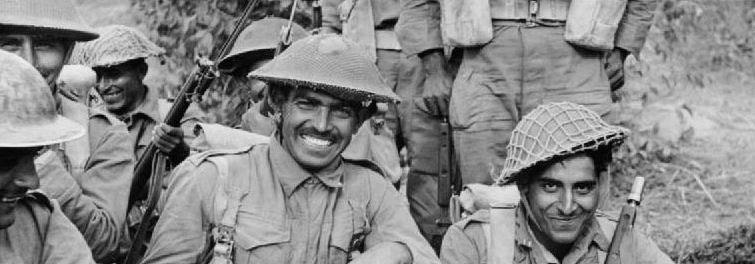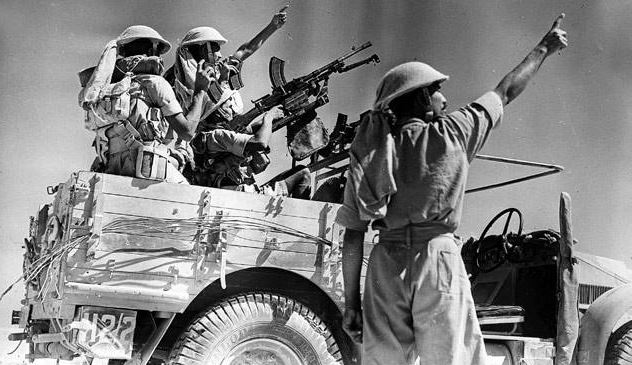
The Indian Army in the Second World War
In 1939, the army numbered 194,373 including 34,515 non-combatants.
Date: 01 Sep 1939
End date: 15 Aug 1945 (All day)
Event location: Italy, Greece, Sicily, France, Britain, Germany, Middle East, North Africa, Burma, Malaya, India, Far East, Pacific
There were:
- 96 infantry battalions
- 18 cavalry regiments - a few had been mechanized, though hampered by lack of tanks and armoured vehicles. The rest retained their horses
One eighth of the army regiments had been 'Indianized' at this time. This process was not completed until 1967. British and Indian officers served side by side.
In addition:
- The India State Forces, personal armies of the Princely States (both cavalry and infantry) comprised 53,000 men
- The Indian Territorial Force and the Auxiliary Force (India), part-time, paid volunteer organisations within the Indian Army, were 19,000 and 22,000 strong respectively.
- There were 15,000 men in the Frontier Force, some of whom could be released to fight elsewhere
There was no shortage of manpower and the men were experienced in battle but lacking weapons and modern equipment, as at the beginning of the First World War.
By 1945 the Indian Army had become the largest volunteer force in history - over 2.5 million men. Infantry, armoured divisions and a fledgling airborne force fought on three continents in Africa, Europe and Asia.
By the end of the war:
- 24, 338 were killed
- 64, 354 were wounded
- 11,754 were missing

Not just men and not just soldiers!
It is important to remember that when nations go to war, though the army provides most of the troops, they are supported by sea and from the air too
In the Second World War, the ships of the Royal Indian Navy (RNI) saw action in the Red Sea, the Indian and Atlantic Oceans, the Bay of Bengal and the Mediterranean, as well as in combined operations off the coasts of Sicily and Burma.
In 1939 the RNI had only eight warships. By 1945 it had 117 combat vessels and 30,000 personnel.
The Indian Air Force (IAF) was formed as late as 1933. Initially a small tactical air force, it grew in size throughout the war, joining forces with the army in the Burma campaign. Many of its officers also served with the Royal Air Force in Burma and other theatres. In recognition of the crucial role played by the IAF, King George VI conferred it the prefix "Royal" in 1945.
In 1939, only one squadron was operational and all training was undertaken by units in the UK. By the end of the war, the number of personnel trained or under training was in excess of 22,000 officers and men.
Indian women served too, many of them nurses in civil and military hospitals or WACs (members of the Women's Auxiliary Corps) performing vital tasks for the war effort just behind the front lines.
They drove army vehicles, operated switchboards and worked as mechanics. During the evacuation of Burma, as the Japanese soldiers advanced, Indian women often stayed at their posts and continued to send vital messages over the telegraph lines to help ensure the escape of as many civilians as possible. Some died overtaken by the advance guards of the Japanese army. In the Far East, the fall of Hong Kong and Singapore led to many army nurses (including Indian) being captured by the Japanese and enduring the terrible hardships and deprivations of the Far East prisoner-of-war camps.
WACs were trained to use weapons and integrated into the regular army. They could choose to wear uniforms with skirts or special military saris. They were given the chance to undertake difficult technical and manual jobs that had been the exclusive preserve of men before the war and often reverted to being so after hostilities ceased in 1945.
People involved: General Auchinleck, Z. A. Bokhari, Subhas Chandra Bose, Dharm Sheel Chowdhary, Kamal Athon Chunchie, Winston Churchill, Indira Devi of Kapurthala, Richard Dimbleby, Cedric Dover, M. K. Gandhi, Sudhindra Nath Ghose, D. F. Karaka, Muhammad Ayub Khan, Noor Inayat Khan, C. L. Katial, Lord Linlithgow, Louis Mountbatten, Jawaharlal Nehru, Mahinder Singh Pujji, General Wavell, Marquess of Zetland.
Indian people at home played a crucial role too, providing huge quantities of supplies including food to Commonwealth forces and to civilians in Britain too. In this way, millions of men and women were indirectly involved in war work.
Undivided India's contribution, it is clear, spread far beyond its army.
You May Be Interested IN